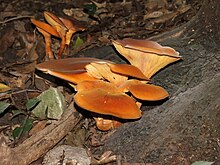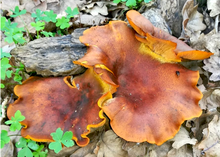Omphalotus olearius
| Omphalotus olearius | |
|---|---|

| |
| Scientific classification | |
| Domain: | Eukaryota |
| Kingdom: | Fungi |
| Division: | Basidiomycota |
| Class: | Agaricomycetes |
| Order: | Agaricales |
| Family: | Omphalotaceae |
| Genus: | Omphalotus |
| Species: | O. olearius
|
| Binomial name | |
| Omphalotus olearius (
DC.) Sing. (1948) | |
| Synonyms[1] | |
| |

Omphalotus olearius,
Unlike chanterelles, Omphalotus olearius and other Omphalotus species contain the toxin illudin S, and are poisonous to humans. While not lethal, consuming this mushroom leads to very severe cramps, vomiting, and diarrhea.
Description
The jack-o'-lantern mushroom is orange. Its bioluminescence, a blue-green color, can be observed in fresh specimens in low light conditions once the eye becomes dark-adapted. The whole mushroom does not glow—only the gills do so. This is due to an enzyme called luciferase, acting upon a compound called luciferin, leading to the emission of light much as fireflies do when glowing.[4]
| Omphalotus olearius saprotrophic | |
|---|---|
| Edibility is poisonous | |
Similar species
Unlike chanterelles, jack-o'-lantern mushrooms have true, sharp, non-forking gills; this is possibly the simplest trait for distinguishing between the two. Furthermore, if the jack-o'-lantern's stem is peeled, the inside is orange, while the chanterelle is paler inside the stem.
Omphalotus illudens of eastern North America, and the Western jack-o'-lantern mushroom Omphalotus olivascens common in southern to central California, are both poisonous. The similarly poisonous mushroom Tsukiyotake (Omphalotus japonicus, formerly known as Lampteromyces japonicus, found in Japan and eastern Asia, is also bioluminescent and contains the same poison, illudin.[3]
See also
Gallery
-
Bioluminescent gills
-
Close up of gills
References
- ^ "Synonymy: Omphalotus olearius (DC.) Singer". Species Fungorum. CAB International. Retrieved 2015-09-24.
- ^ Singer R (1948) In: Pap. Mich. Acad. Sci. 32: 133 ('1946').
- ^ PMID 21148949. Retrieved 2010-05-26.
- PMID 22495263.







